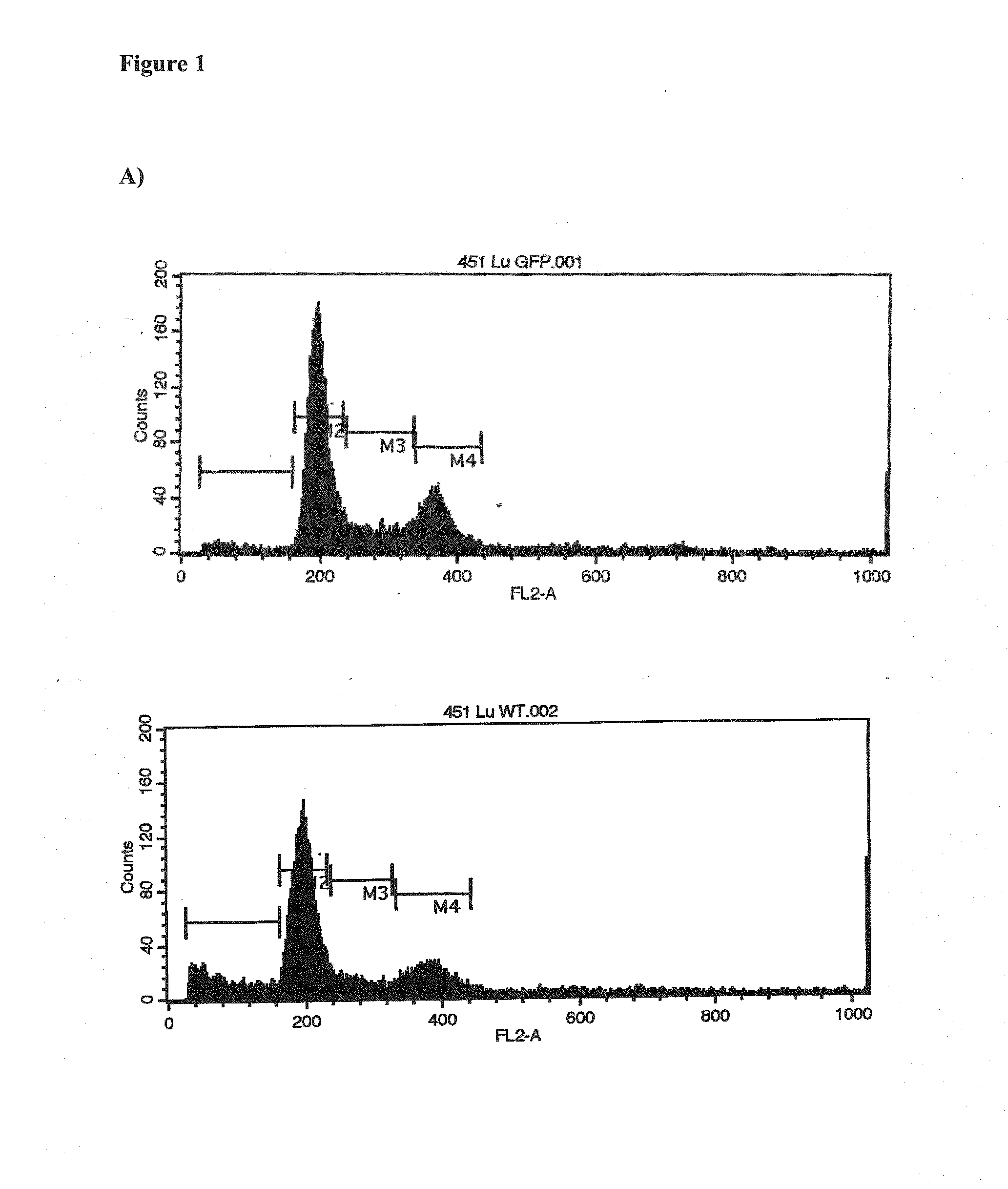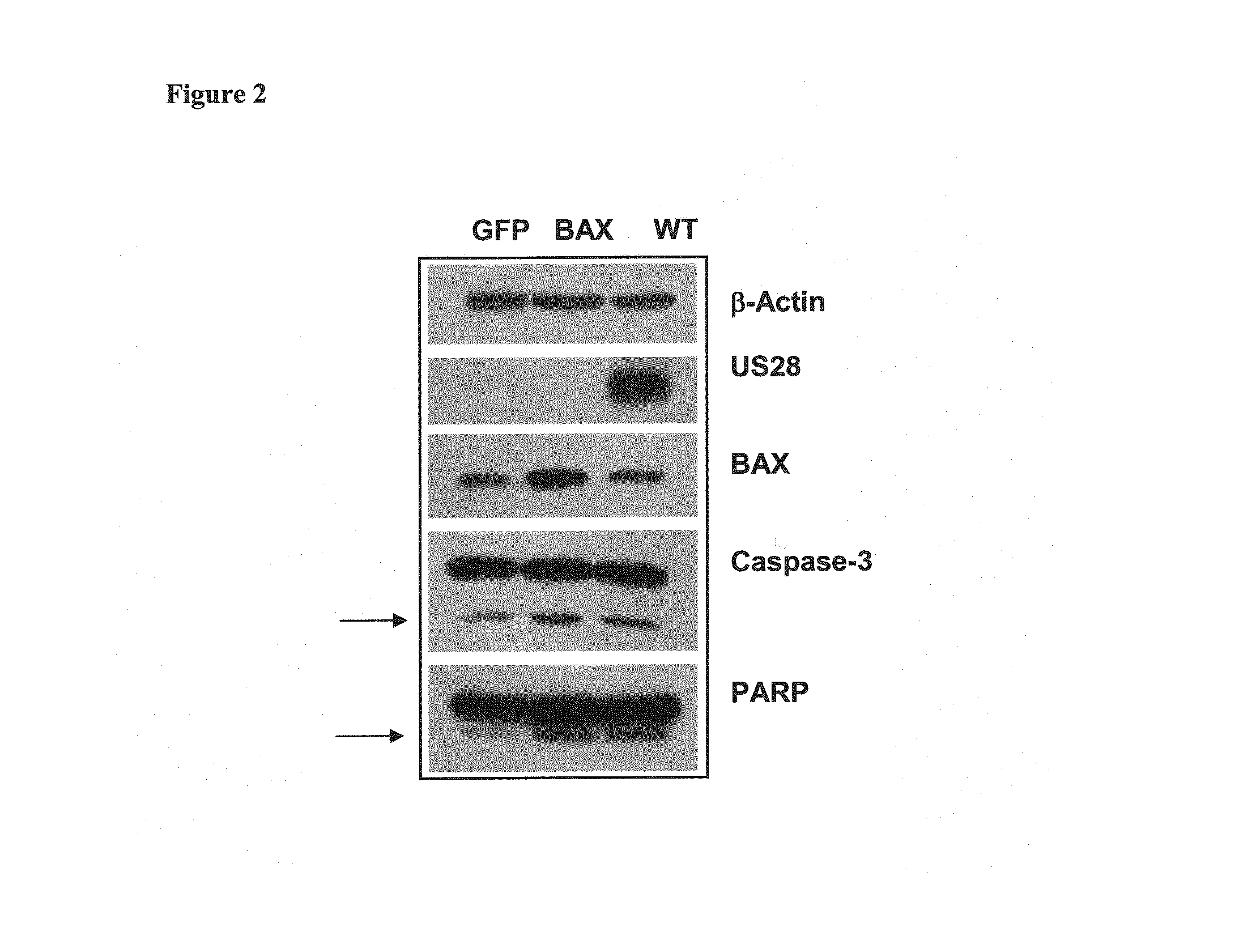Cancer gene therapy using nucleic acids encoding us28 and g-protein
a technology of nucleic acid molecules and cancer genes, applied in the field of cancer gene therapy using nucleic acid molecules encoding us28 and gproteins, can solve the problems of increasing health costs, tumour cell plasticity and heterogeneity, and insufficient specificity, and achieves the effects of improving the specificity of treatment and improving the specificity
- Summary
- Abstract
- Description
- Claims
- Application Information
AI Technical Summary
Benefits of technology
Problems solved by technology
Method used
Image
Examples
example 1
US28 Expression in Melanoma Cells Leads to Caspase Mediated Apoptosis and Reduces Proliferation
[0069]To determine the effect of expression of US28 in melanoma cells, 451Lu cells, a highly aggressive melanoma cell line, were transiently transfected with pcDNA3.1-GFP (Green Fluorescent Protein) and pcDNA3.1-US28 wild type (WT; US28 WT being depicted in SEQ ID NO: 1).
[0070]At 72 hrs post transfection the cells were harvested, fixed, and stained with Propidium iodide (PI) to determine apoptosis stimulated DNA fragmentation by fluorescent activated cell sorting (FACS). Measurements were performed on a BD FACS-Calibur flow cytometer. (B) In parallel total cell count was determined using CASY cell counter system. The results shown are representative of three independent experiments with p value <0.01.
[0071]DNA fragmentation with an increase of about 12% in apoptotic cells for US28 expressing cells compared to control GFP transfected cells was observed. Considering the approximately 40-45% ...
example 2
US28 Effects are Dependent on its Signaling Activity
[0073]The constitutive signaling ability of US28 is suspected to lead to caspase dependent apoptosis. To confirm this and to determine the mechanism of US28, further experiments were performed with inclusion of a signaling mutant of US28, R129A, that lacks the constitutive signaling ability due to mutation at the second intracellular loop at 129 amino acid position 129A (FIG. 3). The nucleotide sequence of US28-R129A is shown in SEQ ID NO: 2.
[0074]Precisely, 451Lu cells transiently transfected with US28WT, US28R129A and control GFP plasmids analyzed at 72 hrs post transfection.
[0075]FIG. 3(A) shows a comparative apoptotic DNA fragment analysis of cells transfected with GFP, WT and R129A that were harvested, fixed, and stained with PI and measurements were performed on BD FACS-Calibur flow cytometer.
[0076]FIG. 3(B) shows the results of 451Lu melanoma cells in 96 well plates that were transfected, and analyzed at 72 hrs after transfe...
example 3
A US28-Gα13 Fusion Protein Enhances Apoptosis Compared to Wild-Type US28
[0086]A fusion protein consisting of US28 and Gα13 was constructed to potentially enhance the apoptosis inducing effects. A fusion construct allows for continuous signaling through Gα13. The fusion protein was generated by linking a nucleic acid sequence encoding US28 to a nucleic acid sequence encoding Gα13. Precisely, the N-terminus of US28 was fused to the N-terminus of Gα13 by a linker-polynucleotide (SEQ ID NO: 9 GCCCTAGGGAATTCTAGAGCG) encoding seven amino acids (ALGNSRA; SEQ ID NO: 10). These amino acids were chosen to ensure that most of them do not contain non-polar side chains thus avoiding negative impact on structure and functionality of the fusion protein. The nucleotide sequence encoding a fusion protein of the invention, and which is used in this example is shown in SEQ ID NO: 8.
[0087]The effect of the fusion protein on induction of apoptosis is shown in FIG. 6. 451Lu melanoma cells were transfecte...
PUM
| Property | Measurement | Unit |
|---|---|---|
| plasticity | aaaaa | aaaaa |
| survival time | aaaaa | aaaaa |
| resistance | aaaaa | aaaaa |
Abstract
Description
Claims
Application Information
 Login to View More
Login to View More - R&D
- Intellectual Property
- Life Sciences
- Materials
- Tech Scout
- Unparalleled Data Quality
- Higher Quality Content
- 60% Fewer Hallucinations
Browse by: Latest US Patents, China's latest patents, Technical Efficacy Thesaurus, Application Domain, Technology Topic, Popular Technical Reports.
© 2025 PatSnap. All rights reserved.Legal|Privacy policy|Modern Slavery Act Transparency Statement|Sitemap|About US| Contact US: help@patsnap.com



